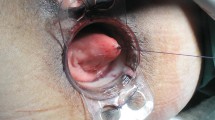Abstract
Background
Constipation is a clinical symptom in patients suffering from slow transit and/or obstructed defecation. Proper treatment requires the identification of all associated disorders and the quantification of symptoms. Rectocele can cause the symptoms of obstructed defecation syndrome (ODS). The aim of this study was to evaluate the clinical and functional outcomes of a novel technique of transvaginal stapled rectal resection (TVSRR) using a straight staple line, to treat rectocele.
Methods
The study included 84 females [median age 51 years (range 29–73 years)], with obstructed defecation, grades II–III rectocele, and multiple abnormalities on defecography. The magnitude and degree of ODS were quantified by the Altomare ODS scoring system. Continence status was evaluated using the Pescatori scoring system. The rectal and vaginal manometric study, the index of patient satisfaction using a visual analog score (VAS), and the validated Patient Assessment of Constipation Quality of Life (PAC-QOL) questionnaire results were recorded. All patients underwent TVSRR.
Results
There were no intraoperative complications. Early postoperative complications were defecatory urgency in seven patients (8.3 %), dyspareunia in two (2.4 %), and rectovaginal fistula in one (1.2 %). Five patients (6 %) had recurrence of ODS symptoms. There was no significant change in continence pre- and postoperatively. The ODS score and VAS revealed significant improvement within the first postoperative year in 94 % of patients. The PAC-QOL questionnaire mean total scores indicated an improvement in both the patient satisfaction and the QOL during the 12-month follow-up. The self-reported definitive outcome was excellent in 46 patients (54.7 %), good in 29 (34.5 %), fairly good in 20 (23.8 %), and poor in five (6.0 %).
Conclusions
Vaginal repair carries no risk of fecal incontinence. Large anterior rectocele is considered the main indication for this technique. Using the linear stapler is a cost-effective, simple, and easy technique.









Similar content being viewed by others
References
Andromanakos N, Skandalakis P, Troupis T, Filippou D (2006) Constipation of anorectal outlet obstruction: pathophysiology, evaluation and management. J Gastroenterol Hepatol 21:638–646
Murad-Regadas SM, Regadas FSP, Rodrigues LV, Fernandes GOS, Buchen G, Kenmoli M (2012) Management of patients with rectocele, multiple pelvic floor dysfunction and obstructed defecation syndrome. Arq Gastroenterol 49:135–142
Rotholtz NA, Efron JE, Weiss EG, Nogueras JJ, Wexner SD (2002) Anal manometric predictors of significant rectocele in constipated patients. Tech Coloproctol 6:73–77
Seong MK, Kim TW (2013) Significance of defecographic parameters in diagnosing pelvic floordyssynergia. J Korean Surg Soc 84:225–230
Talley NJ, Weaver AL, Zinsmeister AR, Melton LJ (1993) Functional constipation and outlet delay: a population study. Gastroenterology 105:781–790
Higgins PN, Johanson JF (2004) Epidemiology of constipation in North America: a systemic review. Am J Gastroentrol 99:750–759
Schwandner O, Stuto A, Jayne D et al (2008) Decision-making algorithm for the STARR procedure in obstructed defecation syndrome: position statement of the group of STARR Pioneers. SurgInnov 15:105–109
Pescatori M, Spyrou M, Pulvirenti d’Uso A (2006) A prospective evaluation of occult disorders in obstructed defecation using “Iceberg diagram”. Colorectal Dis 8:785–789
Shafik A, El-Sibai O, Shafik AA, Ahmed I (2003) On the pathogenesis of rectocele: the concept of the rectovaginal pressure gradient. Int Urogynecol J 14:310–315
Corman ML, Carriero A, Hager T et al (2006) Consensus conference on the stapled transanal rectal resection (STARR) for disordered defecation. Colorectal Dis 8:98–101
Altomare DF, Spazzafumo L, Rinaldi M, Dodi G, Ghiselli R, Piloni V (2007) Set-up and statistical validation of a new scoring system for obstructed defaecation syndrome. Colorectal Dis 10:84–88
Pescatori M, Anastasio G, Bottini C, Mentasti A (1992) New grading and scaling for anal incontinence. Dis Colon Rectum 5:482–487
Schwandner O, Fürst A (2010) Assessing the safety, effectiveness, and quality of life after the STARR procedure for obstructed defecation: results of the German STARR registry. Langenbecks Arch Surg 395:505–513
Marquis P, De La Loge C, Dubois D, McDermott A, Chassany O (2005) Development and validation of the patient assessment of constipation quality of life questionnaire. Scand J Gastroenterol 40:540–551
Reboa G, Gipponi M, Ligorio M, Marino P, Lntieri F (2009) The impact of transanal rectal resection on anorectal function in patients with obstructed defecation syndrome. Dis Colon Rectum 52:1598–1604
Schwandner O, Stuto A, Jayne D et al (2008) Decision-making algorithm for the STARR procedure in obstructed defecation syndrome: position statement of the group of STARR Pioneers. Surg Innov 15:105–109
Shafik A, El-Sibai O, Shafik AA, Ahmed I (2003) On the pathogenesis of rectocele: the concept of the rectovaginal pressure gradient. Int Urogynecol J 14:310–315
Longo A (2004) Obstructed defecation because of rectal pathologies. Novel surgical treatment: stapled transanal rectal resection (STARR). Annual Cleveland Clinic Florida colorectal disease symposium
Pescatori M, Gagliardi G (2008) Postoperative complications after procedure for prolapsed hemorrhoids (PPH) and stapled transanal rectal resection (STARR) procedures. Tech Coloproctol 12:7–19
Gagliardi G, Pescatori M, Altomare DF et al (2008) Results, outcome predictors, and complications after stapled transanal rectal resection for obstructed defecation. Dis Colon Rectum 51:186–195
Boenicke L, Reibetanz J, Kim M, Schlegel N, Germer CT, Isbert C (2012) Predictive factors for postoperative constipation and continence after stapled transanal rectal resection. Br J Surg 99:416–422
Goede AC, Glancy D, Carter H, Mills A, Mabey K, Dixon AR (2011) Medium-term results of stapled transanal rectal resection (STARR) for obstructed defecation and symptomatic rectal-anal intussusception. Colorectal Dis 13:1052–1057
D’Avolio M, Ferrara A, Chimenti C (2005) Transanal rectocele repair using EndoGIA: short-term results of a prospective study. Tech Coloproctol 9:108–114
Pescatori M, Zbar AP (2009) Reinterventions after complicated or failed STARR procedure. Int J Colorectal Dis 24:87–95
Author information
Authors and Affiliations
Corresponding author
Ethics declarations
Conflict of interest
The authors declare that they have no conflict of interest.
Ethical approval
The study was approved by the Ethics Committee of the Cairo University Coloproctology Department.
Informed consent
Informed consent was obtained from all individual participants included in the study.
Rights and permissions
About this article
Cite this article
Shafik, A.A., El Sibai, O. & Shafik, I.A. Rectocele repair with stapled transvaginal rectal resection. Tech Coloproctol 20, 207–214 (2016). https://doi.org/10.1007/s10151-015-1410-6
Received:
Accepted:
Published:
Issue Date:
DOI: https://doi.org/10.1007/s10151-015-1410-6




